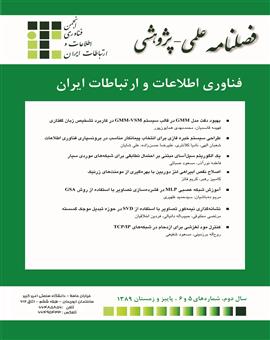اصلاح نقص ابیراهی لنز دوربین با بهرهگیری از مومنتهاي زرنیک
محورهای موضوعی :
1 - دانشگاه آزاد اسلامی واحد تهران مرکز
2 - دانشگاه صنعتی امیرکبیر
کلید واژه: ابیرایی لنز, چند جمله ای زرنیک, طیفهای مرتبه بالاتر,
چکیده مقاله :
کاهش کیفیت تصویر در یک سامانه اپتیکی تابع پارامترهای متفاوتی از قبیل ابیرایی لنز، خطای رقمی سازی و خطای مونتاژ سامانه می باشد. از این میان مقاله حاضر قصد دارد تا به مطالعه ابیرایی لنز پرداخته و نقص ابیرایی آن را اصلاح و جبران نماید. برای این منظور مومنتهای زرنیک جهت مدل سازی ابیرایی معرفی شده و ضرایب آن جهت تخمین در دو کلاس متقارن و نامتقارن دسته بندی میشوند. سپس این ضرایب با بهرهگیری از آنالیز چند طیفی تخمین زده میشوند. جهت این مهم در تخمین ضرایب جملات متقارن از آنالیز tri-coherence و برای ضرایب جملات نامتقارن از آنالیز bi-coherence استفاده شده است. با مد نظر قرار دادن دقت نتایج حاصله در مقام قیاس با نتایج تخمین ابیرایی با بهرهگیری از آنالیز چند طیفی نشان میدهد که روش پیشنهادی میتواند به دقت 1/0 پیکسل دست یابد.
۷۲۹ / ۵٬۰۰۰ The reduction of image quality in an optical system depends on different parameters such as lens aberration, digitization error and system assembly error. Among these, the present article aims to study the astigmatism of the lens and correct and compensate its astigmatism defect. For this purpose, Zernike moments are introduced for the modeling of Abirai and its coefficients are classified into two classes, symmetric and asymmetric. Then these coefficients are estimated using multispectral analysis. For this purpose, tri-coherence analysis has been used to estimate the coefficients of symmetrical sentences, and bi-coherence analysis has been used for the coefficients of asymmetric sentences. Considering the accuracy of the obtained results in comparison with the results of Abirai estimation using multi-spectral analysis, it shows that the proposed method can achieve an accuracy of 0.1 pixel. ارسال بازخورد

